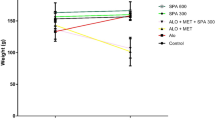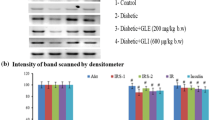Abstract
Gynostemma pentaphyllum (GP) is a natural plant resources for diabetes therapy, however, there is little research on the mechanisms of GP. The present study was undertaken to characterize if G. pentaphyllum saponins (GPs) is the principal active compound of GP responsible for anti-diabetes, and to examine the relativity between blood glucose modulate and antioxidation. The GPs-treated streptozotocin diabetic rats had a more effective hypoglycemic status than those of diabetic control rats, which also ameliorate dyslipidemia. GPs has increased SOD and GSH-px activities, and the spleen and thymus indexes in diabetic rats. The insulin levels in the GPs-treated groups were significantly higher than diabetic control group. Our finding provides a new insight into the application of GPs for the treatment of oxidative stress related diseases.




Similar content being viewed by others
References
Assmann, G., P. Cullen, J. Erbey, D.R. Ramey, F. Kannenberg, and H. Schulte. 2006. Plasma sitosterol elevations are associated with an increased incidence of coronary events in men: Results of a nested case-control analysis of the Prospective Cardiovascular Munster (PROCAM) study. Nutrition, Metabolism & Cardiovascular Diseases 16: 13–21.
Bonnefont-Rousselot, D., J.P. Bastard, M.C. Jaudon, and J. Delattre. 2000. Consequences of the diabetic status on the oxidant/antioxidant balance. Diabetes & Metabolism (Paris) 26: 163–176.
Chen, J.C., K.W. Lu, M.L. Tsai, S.C. Hsu, C.L. Kuo, J.S. Yang, T.C. Hsia, C.S. Yu, S.T. Chou, M.C. Kao, J.G. Chung, and W. Gibson Wood. 2009. Gypenosides induced G0/G1 arrest via CHk2 and apoptosis through endoplasmic reticulum stress and mitochondria-dependent pathways in human tongue cancer SCC-4 cells. Oral Oncology 45: 273–283.
Cohen, G., Y. Riahi, V. Sunda, S. Deplano, C. Chatgilialoglu, C. Ferreri, N. Kaiser, and S. Sasson. 2013. Signaling properties of 4-hydroxyalkenals formed by lipid peroxidation in diabetes. Free Radical Biology Medicine 65: 978–987.
Deng, S., X. Li, B. Chen, F. Deng, and X. Zhou. 1994. Analysis of aminoacids, vitamins and chemical elements in Gynostemma pentaphyllum (Thumb) Makino. Hunan University Medical Journal 19: 487–490.
Gacche, R.N., and N.A. Dhole. 2011. Profile of aldose reductase inhibition, anti-cataract and free radical scavenging activity of selected medicinal plants: An attempt to tandardize the botanicals for amelioration of diabetes complications. Food and Chemical Toxicology 49: 1806–1813.
Gao, D., Q. Li, Y. Li, Z. Liu, Y. Fan, Z. Liu, H. Zhao, J. Li, and Z. Han. 2009. Antidiabetic and antioxidant effects of oleanolic acid from Ligustrum lucidum Ait in alloxan-induced diabetic rats. Phytotherapy Research 23: 1257–1262.
Gao, D., Q. Li, Z. Gao, and L. Wang. 2012. Antidiabetic effects of Corni Fructus extract in streptozotocin-induced diabetic rats. Yonsei Medical Journal 53: 691–700.
Gao, D., Z. Gao, and G. Zhu. 2013. Antioxidant effects of Lactobacillus plantarum via activation of transcription factor Nrf2. Food Function 4: 982–989.
Garcia, E., T.L. OLdOni, S.M. ALEncar, A. ReiS, A. LOGuErciO, and H.M. GrandE. 2012. Antioxidant activity by DPPH assay of potential solutions to be applied on bleached teeth. Brazilian Dental Journal 23: 22–27.
Haan de, J.B. 2011. Nrf2 activators as attractive therapeutics for diabetic nephropathy. Diabetes 60: 2683–2684.
Hou, J., S. Liu, Z. Ma, X. Lang, J. Wang, J. Wang, and Z. Liang. 1991. Effects of Gynostemma pentaphyllum makino on the immunological function of cancer patients. Journal of Traditional Chinese Medicine 11: 47–52.
Huang, T.H., V.H. Tran, B.D. Roufogalis, and Y. Li. 2007. Gypenoside XLIX, a naturally occurring PPAR-alpha activator, inhibits cytokine-induced vascular cell adhesion molecule-1 expression and activity in human endothelial cells. European Journal of Pharmacology 565: 158–165.
Hunt, J.V., C.C.T. Smith, and S.P. Wolff. 1990. Autoxidative glycosylation and possible involvement of peroxides and free radicals in LDL modification by glucose. Diabetes 39: 1420–1424.
Hwang, E.S., and G.H. Kim. 2007. RETRACTED: Biomarkers for oxidative stress status of DNA, lipids, and proteins in vitro and in vivo cancer research. Toxicology 229: 1–10.
Inoguchi, T., P. Li, and F. Umeda. 2000. High glucose level and free fatty acid stimulate reactive oxygen species production through protein kinase C-dependent activation of NAD(P)H oxidase in cultured vascular cells. Diabetes 49: 1939–1945.
Jeong, W.S., M. Jun, and A.N. Kong. 2006. Nrf2: A potential molecular target for cancer chemoprevention by natural compounds. Antioxidants & Redox Signaling 8: 99–106.
Johnson, J.A., D.A. Johnson, A.D. Kra, M.J. Calkins, R.J. Jakel, M.R. Vargas, and P.C. Chen. 2008. The Nrf2–ARE pathway. Annals of the New York Academy of Sciences 1147: 61–69.
Li, L., L. Jiao, and B.H. Lau. 1993. Protective effect of gypenosides against oxidative stress in phagocytes, vascular endothelial cells and liver microsomes. Cancer Biotherapy 8: 263–272.
Masad, A., B.J. Tabner, J. Mayes, and D. Allsop. 2011. The amylin peptide implicated in type 2 diabetes stimulates copper-mediated carbonyl group and ascorbate radical formation. Free Radical Biology & Medicine 51: 869–875.
Matschinsk, F.M. 2009. Assessing the potential of glucokinase activators in diabetes therapy. Nature Review Drug Discovery 8: 399–416.
McMahon, M., K. Itoh, M. Yamamoto, and J.D. Hayes. 2003. Keap1-dependent proteasomal degradation of transcription factor Nrf2 contributes to the negative regulation of antioxidant response element-driven gene expression. Journal of Biological Chemistry 278: 21592–21600.
Megalli, S., F. Aktan, N.M. Davies, and B.D. Roufogalis. 2005. Phytopreventative anti-hyperlipidemic effects of Gynostemma pentaphyllum in rats. Journal of Pharmacy & Pharmaceutical Sciences 8: 507–515.
Newsholme, P., E.P. Haber, S.M. Hirabara, E.L.O. Rebelato, J. Procopio, D. Morgan, H.C. Oliveira-Emilio, A.R. Carpinelli, and R. Curi. 2007. Diabetes associated cell stress and dysfunction: Role of mitochondrial and non-mitochondrial ROS production and activity. Journal of Physiology 583: 9–24.
Nguyen, T., P. Nioi, and C.B. Pickett. 2009. The Nrf2-antioxidant response element signaling pathway and its activation by oxidative stress. Journal of Biological Chemistry 284: 13291–13295.
Nishikawa, T., D. Edelstein, X.L. Du, S. Yamagishi, T. Matsumura, Y. Kaneda, M.A. Yorek, D. Beebe, P.J. Oates, H. Hammes, I. Giardino, and M. Brownlee. 2000. Normalizing mitochondrial superoxide production blocks three pathways of hyperglycaemic damage. Nature 4049: 787–790.
Pertsov, S.S. 2006. Effect of melatonin on the thymus, adrenal glands, and spleen in rats during acute stress. Bulletin of Experimental Biology & Medicine 141: 292–295.
Rask-Madsen, C., and G.L. King. 2007. Mechanisms of disease: Endothelial dysfunction in insulin resistance and diabetes. Nature Clinical Practice Endocrinology & Metabolism 3: 46–56.
Razmovski Naumovski, V., T.H. Huang, V.H. Tran, G.Q. Li, C.C. Duke, and B.D. Roufogalis. 2005. Chemistry and pharmacology of Gynostemma pentaphyllum. Phytochemistry Reviews 4: 197–219.
Surh, Y.J., J.K. Kundu, M.H. Li, H.K. Na, and Y.N. Cha. 2009. Role of Nrf2-mediated heme oxygenase-1 upregulation in adaptive survival response to nitrosative stress. Archives of Pharmacal Research 32: 1163–1176.
Tanner, M.A., X. Bu, J.A. Steimle, and P.R. Myers. 1999. The direct release of nitric oxide by gypenosides derived from the herb Gynostemma pentaphyllum. Nitric Oxide 3: 359–365.
Ak, Tuba, and G. Ilhami. 2008. Antioxidant and radical scavenging properties of curcumin. Chemico-Biological Interactions 174: 27–37.
Whitney, E.J., R.A. Krasuski, B.E. Personius, J.E. Michalek, A.M. Maranian, M.W. Kolasa, E. Monick, B.G. Brown, and J.A.M. Gotto. 2005. A randomized trial of a strategy for increasing high density lipoprotein cholesterol levels: Effects on progression of coronary heart disease and clinical events. Annals of Internal Medicine 142: 45–104.
Xue, M., Q. Qian, A. Adaikalakoteswari, N. Rabbani, R. Babaei Jadidi, and P.J. Thornalley. 2008. Activation of NF-E2-related factor-2 reverses biochemical dysfunction of endothelial cells induced by hyperglycemia linked to vascular disease. Diabetes 57: 2809–2817.
Yoh, K., K. Itoh, A. Enomoto, A. Hirayama, N. Yamaguchi, M. Kobayashi, N. Morito, A. Koyama, M. Yamamoto, and S. Takahashi. 2001. Nrf2-deficient female mice develop lupus-like autoimmune nephritis. Kidney International 60: 1343–1353.
Zhang, D.D. 2006. Mechanistic studies of the Nrf2–Keap1 signaling pathway. Drug Metabolism Reviews 38: 769–789.
Zhang, X.Y., Y. Li, B. Yong, J.T. Liu, and W. Yan. 2007. Study on gynosaponins compound on meliorating memory in mice. Food Science 28: 330–333.
Zhang, Y., X. Li, D. Zou, W. Liu, J. Yang, N. Zhu, L. Huo, M. Wang, J. Hong, P. Wu, G. Ren, and G. Ning. 2008. Treatment of type 2 diabetes and dyslipidemia with the natural plant alkaloid berberine. Journal of Clinical Endocrinology & Metabolism 93: 2559–2565.
Acknowledgments
This work was supported by Hebei Province Natural Science Fund (No. C2011203137, 11965152D) and Foundation of Ministry of Education Doctor Degree (No. 20101333120011).
Author information
Authors and Affiliations
Corresponding author
Rights and permissions
About this article
Cite this article
Gao, D., Zhao, M., Qi, X. et al. Hypoglycemic effect of Gynostemma pentaphyllum saponins by enhancing the Nrf2 signaling pathway in STZ-inducing diabetic rats. Arch. Pharm. Res. 39, 221–230 (2016). https://doi.org/10.1007/s12272-014-0441-2
Received:
Accepted:
Published:
Issue Date:
DOI: https://doi.org/10.1007/s12272-014-0441-2




